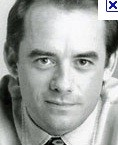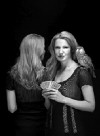Bruce Norris Premiers at Steppenwolf
Parallel Universes Explored
By: Susan Hall - Jul 31, 2010
A Parallelogram
by Bruce Norris
Directed by Anna D. Shapiro
Scenic Design, Todd Rosenthal; Costume Design, Mara Blumenfeld, Lighting Design, James F. Ingalls; Sound Design, Rob Milburn and Michael Bodeen.
Cast: Kate Arrington (Bee), Tom Irwin (Jay), Marylouise Burke (Bee 2,3,4), Tim Bickel (JJ).
Steppenwolf Theatre
Chicago
July 25, 2010
Performances through August 29, 2010
Steppenwolf.org
A Parallelogram by Bruce Norris is a delicious new play from a much-acclaimed playwright. Its subject may sound heavy duty in the telling, but the play is full of wit, humor and extremely touching moments. Interestingly, young people watching the play, and the director who presumably knows the playwright’s intentions, see this play as the forecasting of time future.
Bee, whose point of view is represented, has paranormal vision, and from her present time sees events unfold, many of which she would prefer not happen. Can she control future events from her perch in the present? This question drives her around the bend…maybe. The playwright asks Wallace Shawn’s question: “Why can’t I wake up tomorrow and not be me?”
From older people’s point of view, Bee-as-forecaster is in fact the older Bee looking back over her life and seeing whether or not she could have altered events, or at least what would have happened if she did. As Bee, Kate Arrington, whose cornucopia of talents is familiar to Williamstown audiences, allows us to take in her confusions and struggles. Tantalizing, provocative, this play keeps you on the edge of your seat, wondering what will happen next, or beforehand.
In quantum physics, the parallel universe is not really your past, despite its appearance. Anything you do there doesn’t affect you. Even though everyone looks like family and friends, they’re not. You may be somewhere that looks like a place in which you live or lived, but you are in a quite different reality. This is the gist of both the looking-back or the looking-forward point of view on the play. Once the collider CERN gets up to speed, these questions may be answered.
The future-seeing Bee can watch the dreadful things that are going to happen. She tries to take matters in her own hands. But of course she can’t. Our future is foreordained or our past cannot be changed. How this dilemma impacts on present humans is enacted on stage. Fans of Inception will have even more fun locating themselves in A Parallelogram.
Although Jay, Bee’s boyfriend, is somewhat obtuse, Tom Irwin plays him in a star turn. (He played in Misha’s Party at Williamstown.) Here he richly mines entrances and exits repeated to see if Bee can change them, before or after they’ve occurred. Irwin gives a subtle change to each repetition and aslo captures Jay’s caring for the children he has left behind when he embraced Bee.
Bee is deliberately flattened, to suggest perhaps her place in various times, but occasionally her position is punctuated by surprise. Unable to get Jay’s attention, she lifts her shirt and says, “Look at my breasts.” He doesn’t.
Marylouise Burke, playing Bee at various other stages of her life, as a Tarot card reader and the Spanish-speaking grandma of JJ, is stinging in her accurate prognostications. Her character changes with pinpoint accuracy to enrage and engage. Tim Bickel makes an auspicious Steppenwolf debut as the innocent JJ, whose dumbness may well be faked.
The only clear definition in the play is the intersection of parallel lines in three-dimensional Euclidean geometry. They may intersect, Norris suggests, when emotions from the past and present collide. This happensas Bee can re-imagine her pain at 8 when her parrot bites her. Clearly the feelings for the abandoned children are present always for Bee and Jay at an intersection.
Without pressing this parallel business too far, Bee takes up with the gardener, JJ, an Hispanic immigrant, who probably would not have entered her life had she not taken ten dollars out of the house common money jar to buy an item, and failed to replace it. This left Jay ten dollars short in a payment to JJ. When he goes out to an ATM machine, the romance between Bee and JJ ignites.
A Parallelogram is a thoroughly modern or futuristic take on the most pedestrian of relationships. A cautionary to the irreversibility of the events in our lives, and also a directive to accept and go forward. The play’s frame and the stage are both parallelograms containing Norris’ errant thoughts, which are large and familiar enough to fascinate us too.
As always with Steppenwolf productions, we are intrigued in a new and novel way by plays that are consummately mounted from stem to stern. Or stern to stem.




